[TOC]
# 简介
公司在自己的局域网内搭建自己的远程仓库服务器,称为私服,私服服务器即是公司内部的 maven 远程仓库,每个员工的电脑上安装 maven 软件并且连接私服服务器,员工将自 己开发的项目打成 jar 并发布到私服服务器,其它项目组从私服服务器下载所依赖的构件 (jar)。
私服还充当一个代理服务器,当私服上没有 jar 包会从互联网中央仓库自动下载,如下 图:
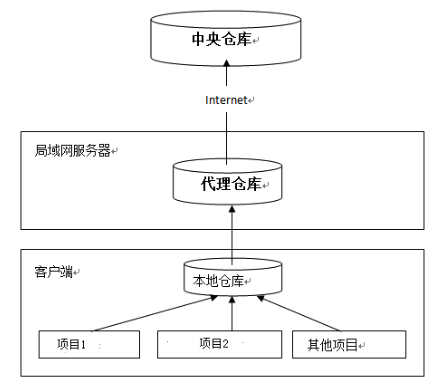
下载 Nexus, 下载地址:http://www.sonatype.org/nexus/archived/
[https://help.sonatype.com/repomanager3/download](https://help.sonatype.com/repomanager3/download)
windows要
cmd 进入 bin 目录,执行 `nexus.bat install`
cmd 进入 bin 目录,执行 `nexus.bat start`
# 配置文件
nexus.properties是配置文件
~~~
# Jetty section
application-port=8081 # nexus 的访问端口配置
application-host=0.0.0.0 # nexus 主机监听配置(不用修改)
nexus-webapp=${bundleBasedir}/nexus # nexus 工程目录
nexus-webapp-context-path=/nexus # nexus 的 web 访问路径
# Nexus section
nexus-work=${bundleBasedir}/../sonatype-work/nexus # nexus 仓库目录 runtime=${bundleBasedir}/nexus/WEB-INF # nexus 运行程序目录
~~~
wrapper.conf这个文件下面改下java的这个
~~~
wrapper.java.command=/Library/Java/JavaVirtualMachines/jdk1.8.0_202.jdk/Contents/Home/bin/java
~~~
默认密码
admin和admin123
[http://127.0.0.1:8081/nexus](http://127.0.0.1:8081/nexus)
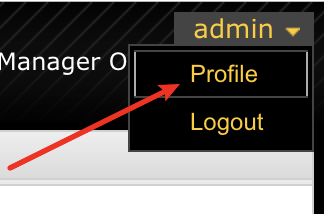
这个里面可以改密码
# 仓库类型
nexus 的仓库有 4 种类型:
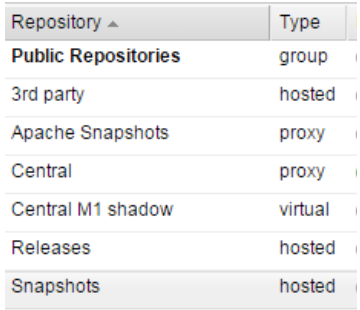
1. hosted,宿主仓库,部署自己的 jar 到这个类型的仓库,包括 releases 和 snapshot 两部 分,Releases公司内部发布版本仓库、 Snapshots 公司内部测试版本仓库
2. proxy,代理仓库,用于代理远程的公共仓库,如 maven 中央仓库,用户连接私服,私服自动去中央仓库下载 jar 包或者插件。
3. group,仓库组,用来合并多个 hosted/proxy 仓库,通常我们配置自己的 maven 连接仓库组。
4. virtual(虚拟):兼容Maven1 版本的jar或者插件
nexus 仓库默认在 sonatype-work 目录中:
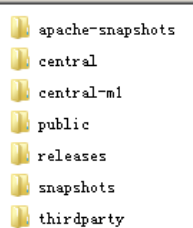
* central:代理仓库,代理中央仓库
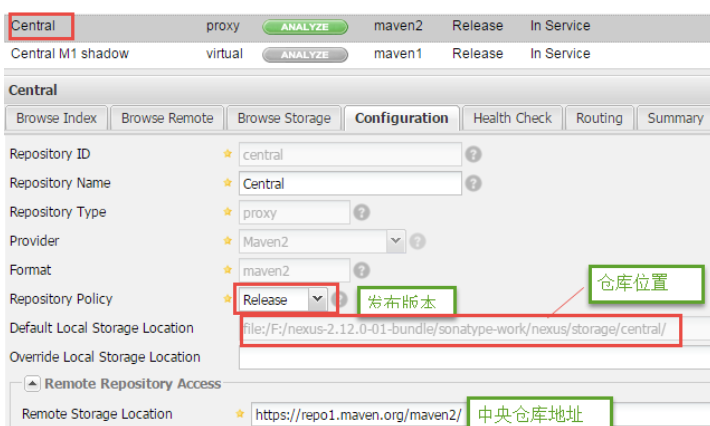
* apache-snapshots:代理仓库
存储 snapshots 构件,代理地址 https://repository.apache.org/snapshots/ central-m1:virtual 类型仓库,兼容 Maven1 版本的 jar 或者插件 releases:本地仓库,存储releases构件。
* snapshots:本地仓库,存储snapshots构件。
* thirdparty:第三方仓库
* public:仓库组

# 发布到私服
## 需求
企业中多个团队协作开发通常会将一些公用的组件、开发模块等发布到私服供其它团队 或模块开发人员使用。
本例子假设多团队分别开发 ssm\_dao、ssm\_service、ssm\_web,某个团队开发完在 ssm\_dao 会将 ssm\_dao 发布到私服供 ssm\_service 团队使用,本例子会将 ssm\_dao 工程打成 jar 包发布到私服。

## 配置
第一步:需要在客户端即部署ssm\_dao工程的电脑上配置 maven环境,并修改 settings.xml 文件,配置连接私服的用户和密码 。
此用户名和密码用于私服校验,因为私服需要知道上传的账号和密码是否和私服中的账号和 密码一致。
~~~
<server>
<id>releases</id>
<username>admin</username>
<password>admin123</password>
</server>
<server>
<id>snapshots</id>
<username>admin</username>
<password>admin123</password>
</server>
~~~
releases 连接发布版本项目仓库
snapshots 连接测试版本项目仓库

第二步: 配置项目 pom.xml
配置私服仓库的地址,本公司的自己的 jar 包会上传到私服的宿主仓库,根据工程的版本号 决定上传到哪个宿主仓库,如果版本为 release 则上传到私服的 release 仓库,如果版本为 snapshot 则上传到私服的 snapshot 仓库
url是私服网页上的对应仓库的url

~~~
<distributionManagement>
<repository>
<id>releases</id>
<name>Nexus Release Repository</name>
<url>http://localhost:8081/nexus/content/repositories/releases/</url>
</repository>
<snapshotRepository>
<id>snapshots</id>
<name>Nexus Snapshot Repository</name>
<url>http://localhost:8081/nexus/content/repositories/snapshots/</url>
</snapshotRepository>
</distributionManagement>
~~~
注意:pom.xml 这里 和 settings.xml 配置对应
你要在dao中把包上传就在dao中deploy的
根据本项目 pom.xml 中 version 定义决定发布到哪个仓库,
如果 version 定义为 snapshot, 执行 deploy 后查看 nexus 的 snapshot 仓库,
如果 version 定义为 release 则项目将发布到 nexus 的 release 仓库,本项目将发布到 release 仓库.
**测试**
可以通过 http 方式查看

# 从私服下载jar包
## 需求
没有配置 nexus 之前,如果本地仓库没有,去中央仓库下载,通常在企业中会在局域网 内部署一台私服服务器,有了私服本地项目首先去本地仓库找 jar,
如果没有找到则连接私 服从私服下载 jar 包,如果私服没有 jar 包私服同时作为代理服务器从中央仓库下载 jar 包,
这样做的好处是一方面由私服对公司项目的依赖 jar 包统一管理,一方面提高下载速度,项 目连接私服下载 jar 包的速度要比项目连接中央仓库的速度快的多。
**在 setting.xml 中配置仓库**
在客户端的 setting.xml 中配置私服的仓库,由于 setting.xml 中没有 repositories 的配置
标签需要使用 profile 定义仓库。
~~~
<profile>
<!--profile 的 id-->
<id>dev</id>
<repositories>
<repository>
<!--仓库 id,repositories 可以配置多个仓库,保证 id 不重复-->
<id>nexus</id>
<!--仓库地址,即 nexus 仓库组的地址-->
<url>http://localhost:8081/nexus/content/groups/public/</url>
<!--是否下载 releases 构件-->
<releases>
<enabled>true</enabled>
</releases>
<!--是否下载 snapshots 构件-->
<snapshots>
<enabled>true</enabled>
</snapshots>
</repository>
</repositories>
<pluginRepositories>
<!-- 插件仓库,maven 的运行依赖插件,也需要从私服下载插件 -->
<pluginRepository>
<!-- 插件仓库的 id 不允许重复,如果重复后边配置会覆盖前边 -->
<id>public</id>
<name>Public Repositories</name>
<url>http://localhost:8081/nexus/content/groups/public/</url>
</pluginRepository>
</pluginRepositories>
</profile>
~~~
使用 profile 定义仓库需要激活才可生效
~~~
<activeProfiles>
<activeProfile>dev</activeProfile>
</activeProfiles>
~~~
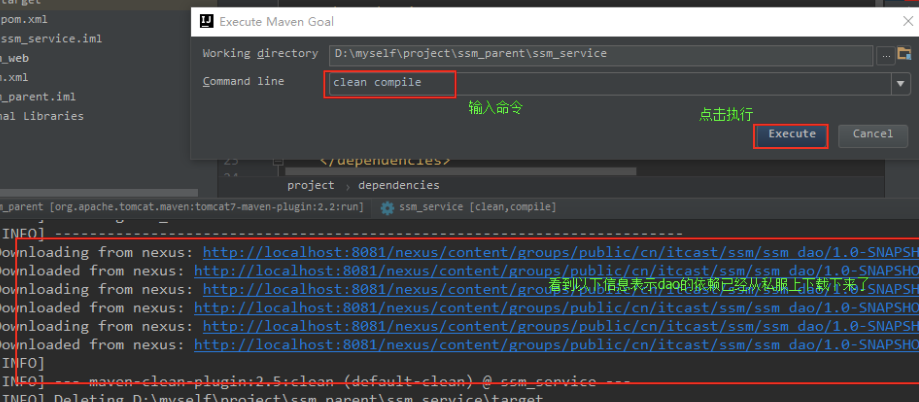
# 第三方jar包安装到本地或私服
1. 导入本地库
2种方式
~~~
----进入jar包所在目录运行
mvn install:install-file -DgroupId=com.alibaba -DartifactId=fastjson -Dversion=1.1.37 -Dfile=fastjson-1.1.37.jar -Dpackaging=jar
----打开cmd直接运行
mvn install:install-file -DgroupId=com.alibaba -DartifactId=fastjson -Dversion=1.1.37 -Dpackaging=jar -Dfile=C:\my_java\fastjson-1.1.37.jar
~~~
然后去仓库看下
2. 导入私服
需要在 maven 软件的核心配置文件 settings.xml 中配置第三方仓库的 server 信息
要能登录到第三方
~~~
<server>
<id>thirdparty</id>
<username>admin</username>
<password>admin123</password>
</server>
~~~
才能执行一下命令
2种方式
~~~
----进入jar包所在目录运行
mvn deploy:deploy-file -DgroupId=com.alibaba -DartifactId=fastjson -Dversion=1.1.37 -Dpackaging=jar -Dfile=fastjson-1.1.37.jar -Durl=http://localhost:8081/nexus/content/repositories/thirdparty/ -DrepositoryId=thirdparty
----打开cmd直接运行
mvn deploy:deploy-file -DgroupId=com.alibaba -DartifactId=fastjson -Dversion=1.1.37 -Dpackaging=jar -Dfile=C:\my_java\fastjson-1.1.37.jar -Durl=http://localhost:8081/nexus/content/repositories/thirdparty/ -DrepositoryId=thirdparty
~~~
**参数说明**
DgroupId 和 DartifactId 构成了该 jar 包在 pom.xml 的坐标,项目就是依靠这两个属性定位。 自己起名字也行。
Dfile 表示需要上传的 jar 包的绝对路径。
Durl 私服上仓库的位置,打开 `nexus——>repositories` 菜单,可以看到该路径。
DrepositoryId 服务器的表示 id,在 nexus 的 configuration 可以看到。
Dversion 表示版本信息,
**关于 jar 包准确的版本: **
包的名字上一般会带版本号,如果没有那可以解压该包,会发现一个叫 MANIFEST.MF 的文件,
这个文件就有描述该包的版本信息。
比如 Specification-Version: 2.2 可以知道该包的版本了。
上传成功后,在 nexus 界面点击 3rd party 仓库可以看到这包。
# 多个私服切换
setting.xml 家和公司两套
activeProfiles属性指定id

# nexus3界面
> Repository:仓储系统
* Blob Stores:这个可以看成是存储空间,管理空间,主要是进行管理Repositorles中仓库的,默认有一个default存储,可以创建存储空间
* Reposltorles:仓库,这就是我们所说的仓库的概念了,仓库一共分为三种类型,宿主(hosted),代理(proxy)和分组(group)
* 宿主:第三方构建所能上传的仓库,可以创建多个name属性不同的宿主仓库,用于管理不同的项目
* 代理:访问网络nexus服务器,用途:打个比方的说,想使用Junit包,但是分组仓库中没有,就需要去访问网络上的中央仓库中下载到你的代理仓库.(因为实际从网络仓库中download的是代理仓库,ps:默认访问网络中仓库的是游客,这个无需去计较了!)
* 分组:分组仓库的主要作用就是将你的宿主仓库和代理仓库进行连接,比如说不同的项目创建的不通的宿主仓库,却使用了相同的代理仓库.这种就可以使用分组仓库进行连接!!!!!!!
* Content Selectors:未知,不了解.从大概的意思上就是nexus组件的使用,和创建自己的组件
> Security:安全管理,账号的权限,SSL证书的配置都在这里
* Prlvileges:每种仓库的增删改查,浏览等权限,可以单独进行配置,被使用于Roles
* Roles:角色权限,相当于一个权限模板,提供给User使用!默认有两种权限,一个是游客(anonymous),一个是管理员(admin)
* Users:用户,这个就是访问nexus私服的用户了,默认同样是有两个,一个是管理员(admin),一个是游客(anonymous),管理员继承了Roles中admin权限模板,具有所有管理权限,而游客只有浏览权限
* Anonymous:游客(或者叫匿名用户) 请忽略他
* LDAP:通讯录? 不了解,请忽略他
* Realms:领域?什么领域? 不了解,请忽略他
* SSL Certlficates:SSL证书配置
> Support:支持,分析系统运行状态,系统信息,日志查看都在这里
* Analytlcs:分析你的组组件在如何的使用Nexus
* Logging:系统各项组件日志
* Metrlcs:内存,线程,磁盘目前使用图
* Support ZIP:选择Support中各种分析文件打成ZIP文件,其中包括系统的运行状态啊,JVM啊,配置文件啊,日志啊等等之类的!
* System InforMation:系统信息,这个比较常用,可以看Nexus运行状态,版本信息,配置文件,组件信息等..... -- System:系统设置
* Bundles:系统插件具体信息的查看,我是这么理解的!有问题,请留言!
* Capabilities:管理和配置你的Nexus具有什么能力,正常使用默认的就好!
* Email Server:Email服务的配置,用于发邮件(在系统出现问题时)
* HTTP: 整体传输协议的配置,默认的就好!
* Licensing:许可证配置,SSL许可证?
* Recent Connections:7天内访问系统信息,都谁访问过nexus服务器
* Nodes:节点管理?
* Tasks:系统任务
## 仓库创建
登录管理界面Administration->Repository->Repositories->左上角Create repository(创建仓库)
我们创建一个Maven2类型的宿主(hosted)仓库(Maven2(hosted)),以下步骤下图所示
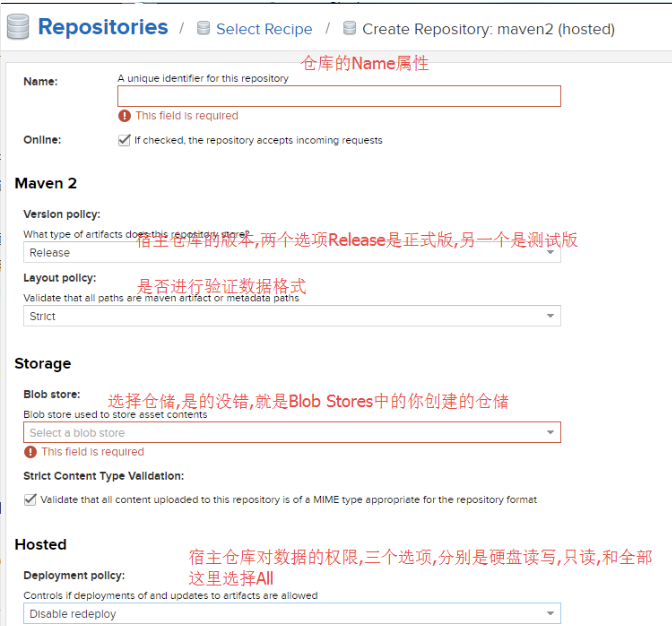
上图提到了Storage仓储的这点,那么下图就去创建一个仓储,仓储是可以创建多个的,每个仓储可以存储不通类型仓库的数据\_ 创建仓储:Repository->Blob Stores->Create blob store,下图所示
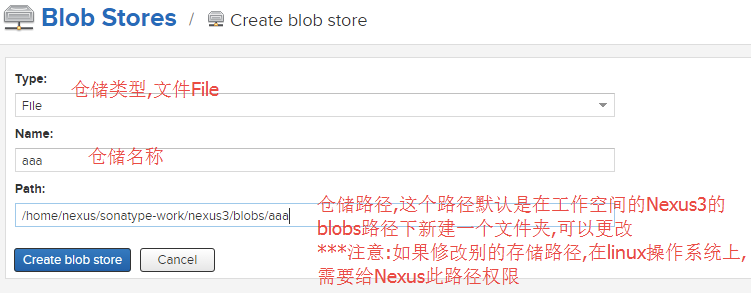
创建步骤重述:先创建仓储,在创建仓库,创建仓库时选择你创建的仓储,就可以了(一个仓库只能选择一个仓储)
## 权限管理
Nexus的权限控制采用的是典型的权限(Privilege)和角色(Role)机制。角色与权限是一对多的关联,用户与角色也是一对多的关联。由于Nexus的主要功能就是管理Maven仓库,所以其权限(Privilege)主要是对仓库进行CRUD(增查改删)操作的权限。作为Nexus的用户,我们能进行管理的就是对仓库的增删改查权限,其他的例如UI权限等是Nexus内建的,用户无法增删改,这个在下一节会讲到。
单个权限(Privilege)所能控制的级别是一个仓库(Repository,包括Group)中存储路径匹配指定正则表达式的一组项目(Artifact)的增删查改(create,delete,read,update)中的某一个操作。正因为其使用了正则表达式来选定要控制的Artifact所以非常灵活。
Nexus的权限分为三类:
1. 应用权限(Application Privilege):主要是用户的UI操作权限和系统管理权限,例如通过UI登录、进行用户管理等。
2. 仓库目标权限(Repository Target Privilege):我们作为用户能自定义的唯一一种权限,就是对仓库中的项目的CRUD操作权限。
3. 仓库浏览权限(Repository View Privilege):通过UI界面浏览一个仓库的权限,在创建每个仓库时,Nexus会自动创建一个对应该仓库的View权限,拥有该仓库的view权限才能在系统的Repositories视图中看到该仓库。
以上三类权限中,应用权限和仓库浏览权限两种是由Nexus创建的,我们并不能对这些权限进行增删改操作,只能选择使用或不使用它们。我们能自定义的权限只有仓库目标权限
---
创建用户:Security->Users->左上角Create user,创建详细如图所示:
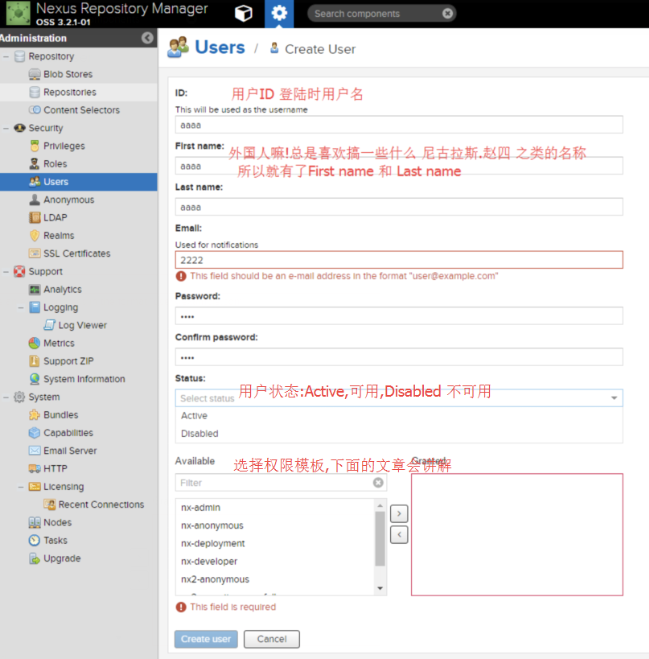
创建用户需要一个用户所属的模板,可以继承多个模板,相当于同时有了多种模板所具有权限,下面进行创建一个模板 创建角色模板:Security->Roles->Create Role->Nexus role
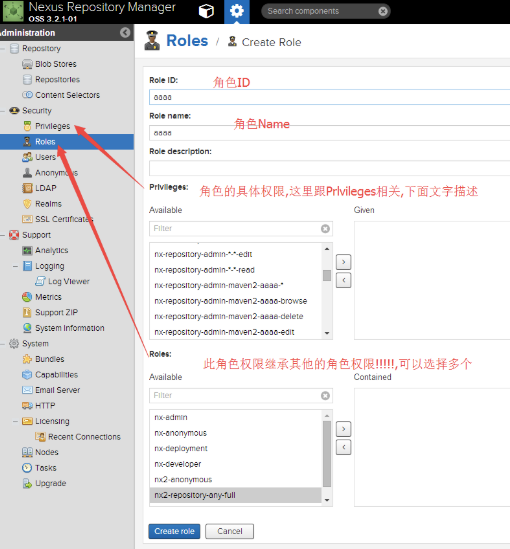
Privileges: 管理仓库的多种权限,以一个我创建的仓库 aaa截图说明:
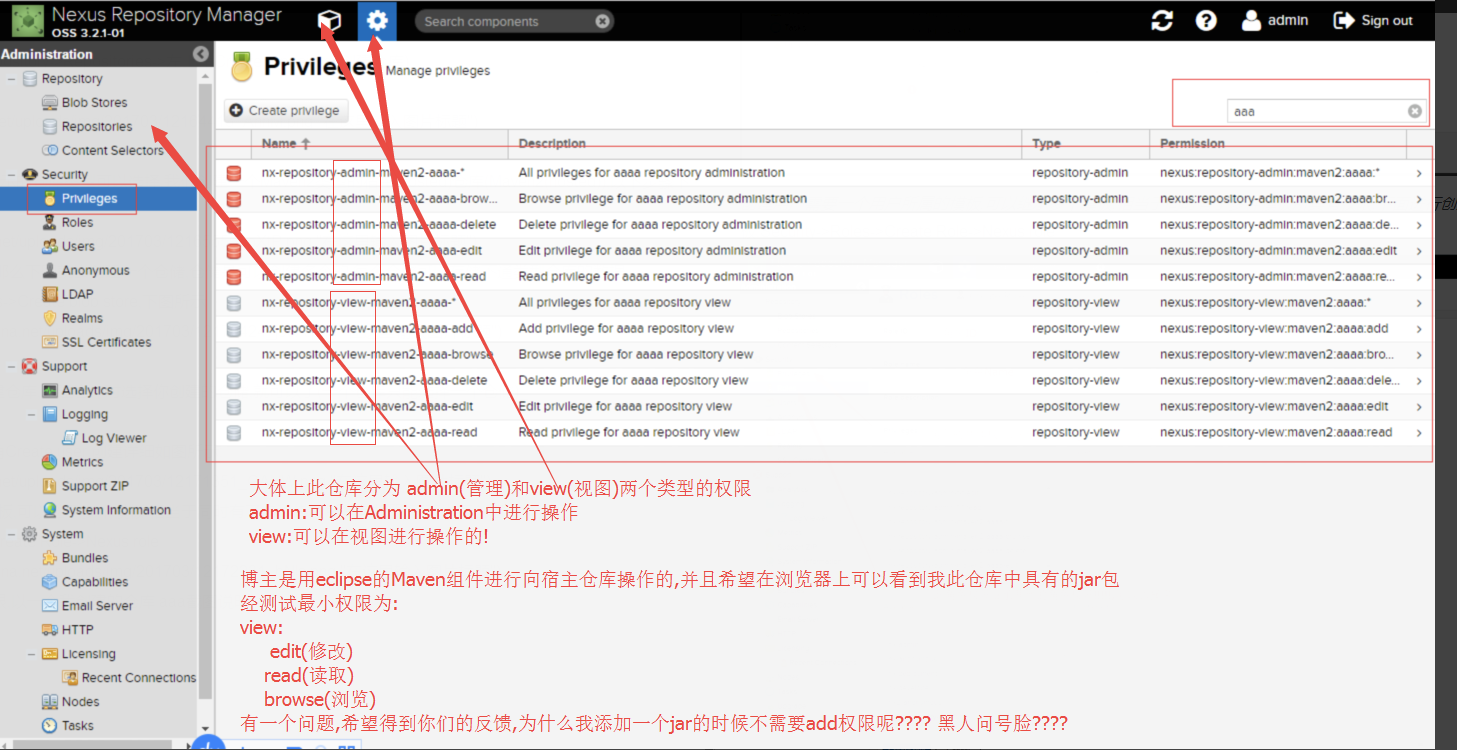
强调:权限管理步骤复述,需要先具有一个角色模板(roles),同时也需要一个Privileges(当构建仓库的时候,默认会构建完成),之后创建User,链接所属Role就可以了*
## 访问
setting.xml
在`<mirrors></mirrors>`标签中添加`mirror`子节点:
~~~xml
<mirror>
<id>maven-private</id>
<mirrorOf>maven-private</mirrorOf>
<url>https://repo.liming.pub/nexus/repository/maven-private/</url>
</mirror>
~~~
或者在`<prifiles></prifiles>`标签中增加增加profile子节点:
~~~xml
<profile>
<id>maven-private</id>
<repositories>
<repository>
<id>maven-private</id>
<url>https://repo.liming.pub/nexus/repository/maven-private/</url>
<snapshots>
<updatePolicy>always</updatePolicy>
</snapshots>
</repository>
</repositories>
</profile>
~~~
在`<servers></servers>`标签中添加`server`子节点:
~~~xml
<server>
<id>maven-private</id>
<username>用户名</username>
<password>密码</password>
</server>
~~~
工程pom中增加发布仓库配置
~~~xml
<profiles>
<profile>
<id>maven-protect</id>
<distributionManagement>
<repository>
<id>maven-protect-releases</id>
<url>https://repo.liming.pub/nexus/repository/maven-protect-releases/</url>
</repository>
<repository>
<id>maven-protect-snapshots</id>
<url>https://repo.liming.pub/nexus/repository/maven-protect-snapshots/</url>
</repository>
</distributionManagement>
</profile>
<profile>
<id>maven-private</id>
<distributionManagement>
<repository>
<id>maven-private-releases</id>
<url>https://repo.liming.pub/nexus/repository/maven-private-releases/</url>
</repository>
<repository>
<id>maven-private-snapshots</id>
<url>https://repo.liming.pub/nexus/repository/maven-private-snapshots/</url>
</repository>
</distributionManagement>
</profile>
</profiles>
~~~
在setting.xml的`<servers></servers>`标签中添加`server`子节点
~~~xml
<server>
<id>maven-private-snapshots</id>
<username>用户名</username>
<password>密码</password>
</server>
<server>
<id>maven-private-releases</id>
<username>用户名</username>
<password>密码</password>
</server>
~~~
## 部署命令
通过maven 的-P参数激活指定的profile
参数的值是profile的id,多个profile以逗号分割,如果不想激活某个默认的profile,就在它的id前加个!
~~~
mvn deploy -Pmaven-private
~~~
查看当前生效的profile:
~~~
mvn help:active-profiles -Pmaven-private
~~~
# maven离线使用
要在无网络访问的环境下使用maven,由于私有仓库无法同步中央仓库,这种情况下,可以将本地仓库整个打包拷贝过去。注意要将各个目录下的`_remote.repositories`文件删除,否则maven也不会使用本地仓库的jar。
删除命令如下:
~~~
find ~/.m2/ -name _maven.repositories | xargs rm
~~~
- 基础
- 编译和安装
- classpath到底是什么?
- 编译运行
- 安装
- sdkman多版本
- jabba多版本
- java字节码查看
- 数据类型
- 简介
- 整形
- char和int
- 变量和常量
- 大数值运算
- 基本类型包装类
- Math类
- 内存划分
- 位运算符
- 方法相关
- 方法重载
- 可变参数
- 方法引用
- 面向对象
- 定义
- 继承和覆盖
- 接口和抽象类
- 接口定义增强
- 内建函数式接口
- 多态
- 泛型
- final和static
- 内部类
- 包
- 修饰符
- 异常
- 枚举类
- 代码块
- 对象克隆
- BeanUtils
- java基础类
- scanner类
- Random类
- System类
- Runtime类
- Comparable接口
- Comparator接口
- MessageFormat类
- NumberFormat
- 数组相关
- 数组
- Arrays
- string相关
- String
- StringBuffer
- StringBuilder
- 正则
- 日期类
- Locale类
- Date
- DateFormat
- SimpleDateFormat
- Calendar
- 新时间日期API
- 简介
- LocalDate,LocalTime,LocalDateTime
- Instant时间点
- 带时区的日期,时间处理
- 时间间隔
- 日期时间校正器
- TimeUnit
- 用yyyy
- 集合
- 集合和迭代器
- ArrayList集合
- List
- Set
- 判断集合唯一
- Map和Entry
- stack类
- Collections集合工具类
- Stream数据流
- foreach不能修改内部元素
- of方法
- IO
- File类
- 字节流stream
- 字符流Reader
- IO流分类
- 转换流
- 缓冲流
- 流的操作规律
- properties
- 序列化流与反序列化流
- 打印流
- System类对IO支持
- commons-IO
- IO流总结
- NIO
- 异步与非阻塞
- IO通信
- Unix的IO模型
- epoll对于文件描述符操作模式
- 用户空间和内核空间
- NIO与普通IO的主要区别
- Paths,Path,Files
- Buffer
- Channel
- Selector
- Pipe
- Charset
- NIO代码
- 多线程
- 创建线程
- 线程常用方法
- 线程池相关
- 线程池概念
- ThreadPoolExecutor
- Runnable和Callable
- 常用的几种线程池
- 线程安全
- 线程同步的几种方法
- synchronized
- 死锁
- lock接口
- ThreadLoad
- ReentrantLock
- 读写锁
- 锁的相关概念
- volatile
- 释放锁和不释放锁的操作
- 等待唤醒机制
- 线程状态
- 守护线程和普通线程
- Lamda表达式
- 反射相关
- 类加载器
- 反射
- 注解
- junit注解
- 动态代理
- 网络编程相关
- 简介
- UDP
- TCP
- 多线程socket上传图片
- NIO
- JDBC相关
- JDBC
- 预处理
- 批处理
- 事务
- properties配置文件
- DBUtils
- DBCP连接池
- C3P0连接池
- 获得MySQL自动生成的主键
- Optional类
- Jigsaw模块化
- 日志相关
- JDK日志
- log4j
- logback
- xml
- tomcat
- maven
- 简介
- 仓库
- 目录结构
- 常用命令
- 生命周期
- idea配置
- jar包冲突
- 依赖范围
- 私服
- 插件
- git-commit-id-plugin
- maven-assembly-plugin
- maven-resources-plugin
- maven-compiler-plugin
- versions-maven-plugin
- maven-source-plugin
- tomcat-maven-plugin
- 多环境
- 自定义插件
- stream
- swing
- json
- jackson
- optional
- junit
- gradle
- servlet
- 配置
- ServletContext
- 生命周期
- HttpServlet
- request
- response
- 乱码
- session和cookie
- cookie
- session
- jsp
- 简介
- 注释
- 方法,成员变量
- 指令
- 动作标签
- 隐式对象
- EL
- JSTL
- javaBean
- listener监听器
- Filter过滤器
- 图片验证码
- HttpUrlConnection
- 国际化
- 文件上传
- 文件下载
- spring
- 简介
- Bean
- 获取和实例化
- 属性注入
- 自动装配
- 继承和依赖
- 作用域
- 使用外部属性文件
- spel
- 前后置处理器
- 生命周期
- 扫描规则
- 整合多个配置文件
- 注解
- 简介
- 注解分层
- 类注入
- 分层和作用域
- 初始化方法和销毁方法
- 属性
- 泛型注入
- Configuration配置文件
- aop
- aop的实现
- 动态代理实现
- cglib代理实现
- aop名词
- 简介
- aop-xml
- aop-注解
- 代理方式选择
- jdbc
- 简介
- JDBCTemplate
- 事务
- 整合
- junit整合
- hibernate
- 简介
- hibernate.properties
- 实体对象三种状态
- 检索方式
- 简介
- 导航对象图检索
- OID检索
- HQL
- Criteria(QBC)
- Query
- 缓存
- 事务管理
- 关系映射
- 注解
- 优化
- MyBatis
- 简介
- 入门程序
- Mapper动态代理开发
- 原始Dao开发
- Mapper接口开发
- SqlMapConfig.xml
- map映射文件
- 输出返回map
- 输入参数
- pojo包装类
- 多个输入参数
- resultMap
- 动态sql
- 关联
- 一对一
- 一对多
- 多对多
- 整合spring
- CURD
- 占位符和sql拼接以及参数处理
- 缓存
- 延迟加载
- 注解开发
- springMVC
- 简介
- RequestMapping
- 参数绑定
- 常用注解
- 响应
- 文件上传
- 异常处理
- 拦截器
- springBoot
- 配置
- 热更新
- java配置
- springboot配置
- yaml语法
- 运行
- Actuator 监控
- 多环境配置切换
- 日志
- 日志简介
- logback和access
- 日志文件配置属性
- 开机自启
- aop
- 整合
- 整合Redis
- 整合Spring Data JPA
- 基本查询
- 复杂查询
- 多数据源的支持
- Repository分析
- JpaSpecificationExecutor
- 整合Junit
- 整合mybatis
- 常用注解
- 基本操作
- 通用mapper
- 动态sql
- 关联映射
- 使用xml
- spring容器
- 整合druid
- 整合邮件
- 整合fastjson
- 整合swagger
- 整合JDBC
- 整合spingboot-cache
- 请求
- restful
- 拦截器
- 常用注解
- 参数校验
- 自定义filter
- websocket
- 响应
- 异常错误处理
- 文件下载
- 常用注解
- 页面
- Thymeleaf组件
- 基本对象
- 内嵌对象
- 上传文件
- 单元测试
- 模拟请求测试
- 集成测试
- 源码解析
- 自动配置原理
- 启动流程分析
- 源码相关链接
- Servlet,Filter,Listener
- springcloud
- 配置
- 父pom
- 创建子工程
- Eureka
- Hystrix
- Ribbon
- Feign
- Zuul
- kotlin
- 基本数据类型
- 函数
- 区间
- 区块链
- 简介
- linux
- ulimit修改
- 防止syn攻击
- centos7部署bbr
- debain9开启bbr
- mysql
- 隔离性
- sql执行加载顺序
- 7种join
- explain
- 索引失效和优化
- 表连接优化
- orderby的filesort问题
- 慢查询
- show profile
- 全局查询日志
- 死锁解决
- sql
- 主从
- IDEA
- mac快捷键
- 美化界面
- 断点调试
- 重构
- springboot-devtools热部署
- IDEA进行JAR打包
- 导入jar包
- ProjectStructure
- toString添加json模板
- 配置maven
- Lombok插件
- rest client
- 文档显示
- sftp文件同步
- 书签
- 代码查看和搜索
- postfix
- live template
- git
- 文件头注释
- JRebel
- 离线模式
- xRebel
- github
- 连接mysql
- 选项没有Java class的解决方法
- 扩展
- 项目配置和web部署
- 前端开发
- json和Inject language
- idea内存和cpu变高
- 相关设置
- 设计模式
- 单例模式
- 简介
- 责任链
- JUC
- 原子类
- 原子类简介
- 基本类型原子类
- 数组类型原子类
- 引用类型原子类
- JVM
- JVM规范内存解析
- 对象的创建和结构
- 垃圾回收
- 内存分配策略
- 备注
- 虚拟机工具
- 内存模型
- 同步八种操作
- 内存区域大小参数设置
- happens-before
- web service
- tomcat
- HTTPS
- nginx
- 变量
- 运算符
- 模块
- Rewrite规则
- Netty
- netty为什么没用AIO
- 基本组件
- 源码解读
- 简单的socket例子
- 准备netty
- netty服务端启动
- 案例一:发送字符串
- 案例二:发送对象
- websocket
- ActiveMQ
- JMS
- 安装
- 生产者-消费者代码
- 整合springboot
- kafka
- 简介
- 安装
- 图形化界面
- 生产过程分析
- 保存消息分析
- 消费过程分析
- 命令行
- 生产者
- 消费者
- 拦截器interceptor
- partition
- kafka为什么快
- kafka streams
- kafka与flume整合
- RabbitMQ
- AMQP
- 整体架构
- RabbitMQ安装
- rpm方式安装
- 命令行和管控页面
- 消息生产与消费
- 整合springboot
- 依赖和配置
- 简单测试
- 多方测试
- 对象支持
- Topic Exchange模式
- Fanout Exchange订阅
- 消息确认
- java client
- RabbitAdmin和RabbitTemplate
- 两者简介
- RabbitmqAdmin
- RabbitTemplate
- SimpleMessageListenerContainer
- MessageListenerAdapter
- MessageConverter
- 详解
- Jackson2JsonMessageConverter
- ContentTypeDelegatingMessageConverter
- lucene
- 简介
- 入门程序
- luke查看索引
- 分析器
- 索引库维护
- elasticsearch
- 配置
- 插件
- head插件
- ik分词插件
- 常用术语
- Mapping映射
- 数据类型
- 属性方法
- Dynamic Mapping
- Index Template 索引模板
- 管理映射
- 建立映射
- 索引操作
- 单模式下CURD
- mget多个文档
- 批量操作
- 版本控制
- 基本查询
- Filter过滤
- 组合查询
- 分析器
- redis
- String
- list
- hash
- set
- sortedset
- 发布订阅
- 事务
- 连接池
- 管道
- 分布式可重入锁
- 配置文件翻译
- 持久化
- RDB
- AOF
- 总结
- Lettuce
- zookeeper
- zookeeper简介
- 集群部署
- Observer模式
- 核心工作机制
- zk命令行操作
- zk客户端API
- 感知服务动态上下线
- 分布式共享锁
- 原理
- zab协议
- 两阶段提交协议
- 三阶段提交协议
- Paxos协议
- ZAB协议
- hadoop
- 简介
- hadoop安装
- 集群安装
- 单机安装
- linux编译hadoop
- 添加新节点
- 退役旧节点
- 集群间数据拷贝
- 归档
- 快照管理
- 回收站
- 检查hdfs健康状态
- 安全模式
- hdfs简介
- hdfs命令行操作
- 常见问题汇总
- hdfs客户端操作
- mapreduce工作机制
- 案例-单词统计
- 局部聚合Combiner
- combiner流程
- combiner案例
- 自定义排序
- 自定义Bean对象
- 排序的分类
- 案例-按总量排序需求
- 一次性完成统计和排序
- 分区
- 分区简介
- 案例-结果分区
- 多表合并
- reducer端合并
- map端合并(分布式缓存)
- 分组
- groupingComparator
- 案例-求topN
- 全局计数器
- 合并小文件
- 小文件的弊端
- CombineTextInputFormat机制
- 自定义InputFormat
- 自定义outputFormat
- 多job串联
- 倒排索引
- 共同好友
- 串联
- 数据压缩
- InputFormat接口实现类
- yarn简介
- 推测执行算法
- 本地提交到yarn
- 框架运算全流程
- 数据倾斜问题
- mapreduce的优化方案
- HA机制
- 优化
- Hive
- 安装
- shell参数
- 数据类型
- 集合类型
- 数据库
- DDL操作
- 创建表
- 修改表
- 分区表
- 分桶表
- DML操作
- load
- insert
- select
- export,import
- Truncate
- 注意
- 严格模式
- 函数
- 内置运算符
- 内置函数
- 自定义函数
- Transfrom实现
- having和where不同
- 压缩
- 存储
- 存储和压缩结合使用
- explain详解
- 调优
- Fetch抓取
- 本地模式
- 表的优化
- GroupBy
- count(Distinct)去重统计
- 行列过滤
- 动态分区调整
- 数据倾斜
- 并行执行
- JVM重用
- 推测执行
- reduce内存和个数
- sql查询结果作为变量(shell)
- youtube
- flume
- 简介
- 安装
- 常用组件
- 拦截器
- 案例
- 监听端口到控制台
- 采集目录到HDFS
- 采集文件到HDFS
- 多个agent串联
- 日志采集和汇总
- 单flume多channel,sink
- 自定义拦截器
- 高可用配置
- 使用注意
- 监控Ganglia
- sqoop
- 安装
- 常用命令
- 数据导入
- 准备数据
- 导入数据到HDFS
- 导入关系表到HIVE
- 导入表数据子集
- 增量导入
- 数据导出
- 打包脚本
- 作业
- 原理
- azkaban
- 简介
- 安装
- 案例
- 简介
- command类型单一job
- command类型多job工作流flow
- HDFS操作任务
- mapreduce任务
- hive脚本任务
- oozie
- 安装
- hbase
- 简介
- 系统架构
- 物理存储
- 寻址机制
- 读写过程
- 安装
- 命令行
- 基本CURD
- java api
- CURD
- CAS
- 过滤器查询
- 建表高级属性
- 与mapreduce结合
- 与sqoop结合
- 协处理器
- 参数配置优化
- 数据备份和恢复
- 节点管理
- 案例-点击流
- 简介
- HUE
- 安装
- storm
- 简介
- 安装
- 集群启动及任务过程分析
- 单词统计
- 单词统计(接入kafka)
- 并行度和分组
- 启动流程分析
- ACK容错机制
- ACK简介
- BaseRichBolt简单使用
- BaseBasicBolt简单使用
- Ack工作机制
- 本地目录树
- zookeeper目录树
- 通信机制
- 案例
- 日志告警
- 工具
- YAPI
- chrome无法手动拖动安装插件
- 时间和空间复杂度
- jenkins
- 定位cpu 100%
- 常用脚本工具
- OOM问题定位
- scala
- 编译
- 基本语法
- 函数
- 数组常用方法
- 集合
- 并行集合
- 类
- 模式匹配
- 异常
- tuple元祖
- actor并发编程
- 柯里化
- 隐式转换
- 泛型
- 迭代器
- 流stream
- 视图view
- 控制抽象
- 注解
- spark
- 企业架构
- 安装
- api开发
- mycat
- Groovy
- 基础
